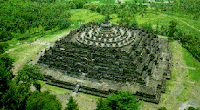 |
| Borobudur Temple from side |
Borobudur is the largest Buddhist temple in the 9th century measuring 123 x 123 meters. Borobudur was completed centuries before Angkor Wat in Cambodia. This Buddhist temple has 1460 relief panels and 504 Buddha effigies in the complex. Millions of people are yearning to visit the buildings included in this World Wonder Heritages.
Borobudur was built by King Samaratungga, one of the kings of Old Mataram Kingdom, Dynasty descendant dynasty. Based Kayumwungan inscription, an Indonesian named Hudaya Kandahjaya revealed that Borobudur is a place of worship was completed on 26 May 824, almost a hundred years from the time the construction. Architects who contributed to build this temple according to a story passed down through generations named Gunadharma.
Borobudur own words based on the first written evidence that was written by Sir Thomas Stamford Raffles, Governor General of the United Kingdom in Java, which gives the name of this temple.There is no written evidence that older who gave the name of this temple of Borobudur. Only one of the oldest document showing the existence of this temple is Nagarakretagama book, written by the MPU Prapanca in the year 1365. In the book was written that this temple was used as a place of Buddhist meditation.
Meaning of the name Borobudur "abbey in the hills", which comes from the word "coal" (temple or monastery) and "beduhur" (hills or high ground) in Sanskrit. Therefore, in accordance with the meaning of the name Borobudur, then this place since long ago used as a place of Buddhist worship.
 |
| Stupa in Borobudur Temple |
Borobudur-shaped building with staircase punden consists of 10 levels. Height 42 meters before it was renovated and 34.5 meters after the renovation because the lowest level is used as a drag. Six lowest level of a square and three levels on top of a circle and one of the highest levels of Buddhist stupa facing to the west. Each level represents the stages of human life. In accordance madhhabs Mahayana Buddhism, every person who wants to reach the level as the Buddha had to through every level of life is.
The base of Borobudur, called Kamadhatu, symbolizing human beings that are still bound by lust. Four levels above referred Rupadhatu symbolizes man who had to break free from lust but still bound manner and form. On this terrace, Buddha effigies are placed in open space. Meanwhile, three levels above where the Buddhist stupas are laid in holes called Arupadhatu, symbolizing man who has been free from lust, appearance, and shape. The top part is called Arupa symbolizes nirvana, where Buddha is residing.
 |
| Borobudur Temple from the air |
This temple for centuries no longer used. Then, because of volcanic eruptions, most of the buildings covered Borobudur volcanic soil. In addition, the building is also covered with various trees and shrubs for centuries. Then the building of this temple began forgotten in the time Islam arrived in Indonesia around the 15th century.
In 1814 when the British occupied Indonesia, Sir Thomas Stamford Raffles heard of the discovery of huge archaeological objects in the village of Magelang district Bumisegoro. Due to great interest of the history of Java, then immediately ordered Raffles HCCornelius, a Dutch engineer, to investigate the discovery of the location was a hill covered with shrubs.
Cornelius assisted by about 200 men cut down trees and remove shrubs that covered the giant building. Because the building is already fragile and could collapse, then report to the Raffles Cornelius invention includes several images. Since the discovery, Raffles was awarded as the man who started restoration of Borobudur temple and got the attention of the world. In 1835, the entire area of the temple has been unearthed. The temple is kept restored in the Dutch colonial period.
After Indonesian independence, in 1956, the Indonesian government requested the assistance of UNESCO to examine the damage to Borobudur. Then in 1963, out of the official Indonesian government's decision to conduct the restoration of Borobudur temple with the help of UNESCO. However, this restoration was only really started to be done on August 10, 1973. Process new refurbishment completed in 1984. Since 1991, Borobudur designated as World Heritage or World Heritage Site by UNESCO.


No comments:
Post a Comment